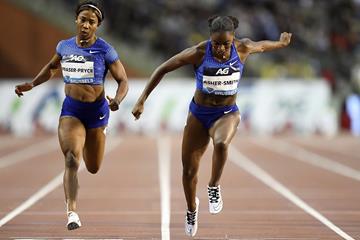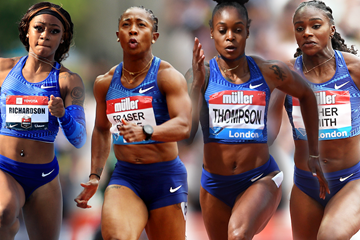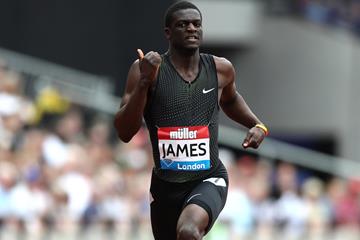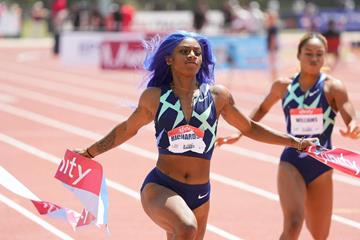 Countdown
Countdown
 Countdown
Countdown
The 100m is arguably the most popular track and field event in the world, with many elite athletes gaining worldwide fame and notoriety by winning this blue riband event.
The original event in the Ancient Olympics was the stade, a 192m race
Athletes stick to a lane and run down a straight 100m track, which is generally the straight section of a standard 400m track
The men’s 100m sprint made its debut at the 1896 Olympics, while the women’s 100m was introduced in 1928
Athletes start the race on blocks, which include sensors to detect false starts
The fastest time wins the race and often places are separated by thousandths of a second
The 100m is the shortest distance contested on the Olympic track and field programme
There have been many celebrated 100m world records throughout history. In fact, world record-holders and champions often become household names thanks to the event’s popularity and its status as the marquee event at most major championships.
The first women’s 100m world record was set by Czechoslovakia’s Marie Mejzlikova, who ran 13.6 seconds on 5 August 1922. However, this was broken just a couple of weeks later by British runner Mary Lines, who registered 12.8.
The first sub-11 second time was set by East German athlete Renate Stecher in June 1973. She completed the 100m in 10.9.
From 1977, World Athletics would only accept times if they were recorded automatically to one-hundredth of a second. This made recording times for the event far more accurate and reliable.
In July 1988, US athlete Florence Griffith-Joyner achieved the current world record of 10.49. The athletes to have got closest to that mark since are Jamaicans Elaine Thompson-Herah and Shelly-Ann Fraser-Pryce, who respectively ran 10.54 and 10.60 in 2021.
Before the world records were ratified by World Athletics, 15 athletes achieved the first men’s 100m world record time of 10.8. US runner Luther Cary was the first to do so in July 1891, and Swede Eric Frick was the last in August 1903.
From 1912, World Athletics ratified world records in the men’s 100m, and the first athlete to set a ratified mark was US runner Donald Lippincott with 10.6. The first athlete to achieve a time of under 10 seconds was Jim Hines, who ran 9.95 in 1968.
Just like with the women’s event, from 1977 only automatically recorded times were accepted as world records. In August 1991, US athlete Carl Lewis achieved the first-ever sub-9.90 time, with 9.86. That record stood for almost three years, until fellow US runner Leroy Burrell broke it by just a hundredth of a second.
The year 2005 saw the start of Jamaica’s dominance in the men’s 100m sprint, when Asafa Powell broke the world record with a time of 9.77. Powell went on to match that record a further two times before he improved it to 9.74 in 2007.
In May 2008, his fellow Jamaican runner and one of the biggest names in athletics history, Usain Bolt, claimed the world record with a time of 9.72. Just a few months later, in August of that year, Bolt broke his own record with 9.69. One year later, he broke it again with a time of 9.58. Bolt has held the record since then, meaning he retains the title of ‘the fastest man in the world’ despite retiring in 2017.
As this is the marquee event of the Olympics, World Athletics Championships and many other events in track and field, there are many renowned 100m champions who have excelled and become both celebrities and sporting legends.
Notable names in men’s 100m sprinting include 1936 Olympic champion Jesse Owens and two-time Olympic gold medallist Carl Lewis. Plus, there’s the incomparable Usain Bolt, who won gold in the 100m at the Games in 2008, 2012 and 2016.
Celebrated women’s 100m sprinters include Olympic gold medallist and world record-holder Florence Griffith-Joyner, two-time Olympic and five-time world champion Shelly-Ann Fraser-Pryce, two-time Olympic champion Elaine Thompson-Herah and 2023 World Championships gold medallist Sha'Carri Richardson.
Historically, the US has proved to be the world’s most dominant force over 100m, but seven of the past eight Olympic 100m titles (four women's and three men's) have been won by Jamaican athletes.

The 100m sprint is a short but incredibly intense race. Elite athletes use all their skill, speed, agility and strength to run at top speed for around 10 seconds. Added to this, athletes must also demonstrate precise technique, balance and timing to ensure they get the fastest possible time while also avoiding disqualification.
The correct 100m sprint technique can be broken down into various phases:
Athletes are assigned a lane and a starting block. The front block is two feet from the line and the rear block is three feet from the line. The dominant foot is placed in the front block to give the athlete the strongest possible start.
Athletes also place their hands on the ground for balance just behind the start line.
The call, ‘On your marks,’ is made. At this point, athletes get into their starting position with their bodies low and centred, and their eyes forwards.
When, ‘Set,’ is called, athletes raise their hips and tense their leg muscles as they prepare to push off from the blocks.
The starting pistol is fired to signal the start of the race. Athletes then push off from the starting blocks by putting all their power into both legs.
Sensors in the blocks will measure whether an athlete commits a false start. If they do, they’re disqualified.
Athletes maintain a low position, leaning forward for the first 10 to 15 metres as they focus on making quick, powerful strides.
Athletes transition into an upright position while continuing to accelerate. At this stage, they also lengthen their strides.
Athletes achieve a balance between speed and stride length. At this point of the race, they hit their maximum speed. The focus is then on maintaining this speed for as long as possible and attempting to ignore any feelings of pain, discomfort or fatigue.
The athlete whose torso crosses the line first wins. So, as athletes approach the line, they lean forward to gain the advantage. Athletes must always maintain speed and not slow down, as a competitor could be just a hundredth of a second behind them.
The 100m sprint rules are simple and fair. A notable infringement of the rules came in 2011, when Usain Bolt was disqualified at the World Championships for a false start.
A reaction time of less than 0.1 seconds is deemed a false start. All athletes are recalled and the offender is disqualified.
An athlete can be disqualified for obstructing another runner or unsporting behaviour.
The winner is the athlete whose torso crosses the finish line first. Any other body parts that cross the finish line first, like the head, hands or feet, are disregarded.
A 100m sprint time will only be considered ‘wind legal’ if the wind speed is 2m/s or less. This is determined by an anemometer close to the track.
The average 100m sprint time for elite athletes is around 10 seconds for men and 11 seconds for women.
The men’s 100m world record is currently held by Usain Bolt with a time of 9.58. Meanwhile, the women’s 100m world record is held by Florence Griffith-Joyner, with 10.49.
To excel at the 100m sprint, you must have incredible speed, spot-on timing and precise technique. If you’re looking to train for the 100m sprint, here’s what you should bear in mind:
Build strength training into your routine, including lifting weights and focusing on your core
Practise regular speed and agility drills to improve footwork and speed
Regularly use starting blocks as part of your training
Work on your stride length and frequency
Regularly sprint distances greater than 100m, such as 200m, to build endurance
Always warm up and cool down to prevent injury and perform optimally
Make sure you rest every other day to promote recovery and reduce the risk of injury
Eat a healthy and balanced diet
Always stay hydrated
Create a training plan and stick to it, focusing on speed, technique, strength, endurance and agility on set days – and don’t forget the rest.
 JAM
JAM
 JAM
JAM
 RSA
RSA
 USA
USA
 USA
USA
 USA
USA
 GBR
GBR
 USA
USA
 JAM
JAM
 GBR
GBR
 USA
USA
 LCA
LCA
 JAM
JAM
 CIV
CIV
 GBR
GBR
 JAM
JAM
 JAM
JAM
 USA
USA
 USA
USA
 JAM
JAM







